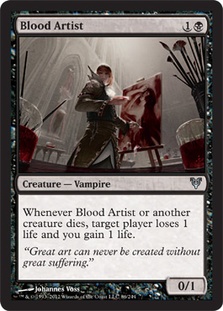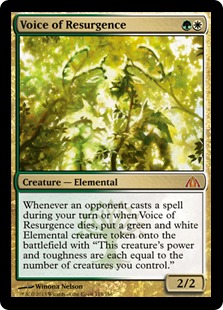Do you like drawing cards?
Do you prefer decks that don’t care about opposing removal spells?
Is the graveyard an important resource for you?
Do you think that combat steps are for losers?*
Magic is a wonderful game because it caters to so many different play styles. Decks that attack with small guys, decks that summon huge unstoppable creatures, decks that burn their opponent’s face off—but if you answered yes to the above questions, there is a special deck in Standard for you.
Clearly, the right deck for you is Esper Control Immortal Servitude!
How sweet is this deck. Voice of Servitude is what I dub it: bit.ly/10kQDf1 #SCGPITT
— Evan Erwin (@misterorange) May 13, 2013
Creatures (26)
- 2 Elvish Visionary
- 1 Bloodthrone Vampire
- 4 Skirsdag High Priest
- 4 Strangleroot Geist
- 4 Blood Artist
- 3 Deathrite Shaman
- 4 Cartel Aristocrat
- 4 Voice of Resurgence
Planeswalkers (1)
Lands (23)
Spells (10)

Upon Gatecrash’s release, I heard whispers of an Immortal Servitude combo deck, but I never saw it in action. Validated by a strong finish at the 168 player StarCityGames.com Classic Series in Pittsburgh, Elliot Smith’s decklist warranted a closer look. I fired up Magic Online, paid a tenth of a ticket for the two Immortal Servitudes I needed, and played a few games. Attack for two, attack for two, chump block, chump block, cast Immortal Servitude, victory. Major props to Evan Erwin for tweeting about this gem last week.
This. Deck. Is. AWESOME!**
The Combo
So what actually happens when we “go off”?
For those of you looking at this decklist and scratching your head, I will help you a bit. Turn 1 cast a Deathrite Shaman. Turn 2 cast Grisly Salvage, putting Blood Artist, Elvish Visionary, and Voice of Resurgence in your graveyard. Turn 3 cast another Grisly Salvage, putting Cartel Aristocrat and Blood Artist in the graveyard.
Turn 4 cast Immortal Servitude with X = 2.
The following creatures enter the battlefield: Blood Artist, Blood Artist, Elvish Visionary, Voice of Resurgence, and Cartel Aristocrat. What happens next? Answer: whatever we want. Step 1 is to draw a card off the Elvish Visionary. If our life total is low, we can sacrifice a few creatures to Cartel Aristocrat, draining our opponent for two each time, and Voice of Resurgence provides us with a second creature to sacrifice should the situation require it. Speaking of Voice of Resurgence, we can just sacrifice the 2/2 and be content with the 6/6 it leaves behind. If we found a Gavony Township off of one of the Grisly Salvages, we can play it and start beating down. At the very least we can sacrifice our board, draining our opponent for eleven with this board state alone.
Did I mention we drew a card off of this?
And what if we have another Immortal Servitude sometime in the near future?
Nice Thragtusk.
The Game Plan
The nut draw seems pretty nice, but as we all know that isn’t a huge percentage of actual Magic. What does a normal game look like? Well, we’re probably going to lead off with a two-drop of some sort, maybe attack a few times, then finish our opponent off with Gavony Township + creatures, Vault of the Archangel + creatures, a Skirsdag High Priest activation, Blood Artist, or the namesake card Immortal Servitude. That’s a pretty good plan if the game stalls out, and a deck full of small creatures is prone to doing exactly that. Removal spells are particularly ineffective against this creature deck; most creatures replace themselves in one way or another or, in the case of Cartel Aristocrat, protect themselves.
Where this deck truly shines is against midrange decks. No number of Thragtusks or Huntmaster of the Fells will save someone from multiple fully loaded Immortal Servitudes, and they’re not killing us fast enough to be a huge worry. Additionally, Jund and G/B/W Reanimator have very few ways to interact with expensive sorceries, limited to generally two copies of either Rakdos’s Return or Sin Collector.
Perhaps the most unintuitive part about playing this deck is the fact that chump blocking is often advantageous. With an Immortal Servitude in hand, a creature that dies is better than one in play. Every creature that dies triggers its death trigger and its enters the battlefield trigger for free. You’re casting that Immortal Servitude for two anyway, right? What does it matter if there are two creatures in your graveyard or ten? You get them all back.
The Problem Cards

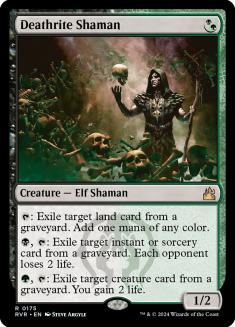
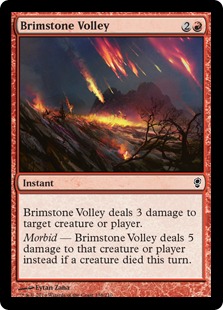
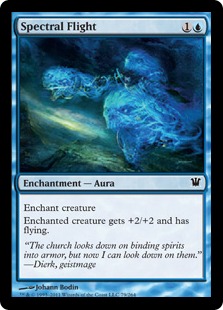
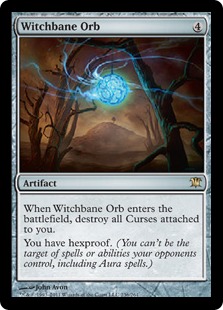
Ah yes, no strategy would be complete without its weaknesses. As mentioned above, the strategy of “chump block a few times then win instantly” is pretty strong against cards that are useful against creature strategies, like Thragtusk, Boros Reckoner, and a plethora of removal spells. However, certain cards or strategies can give us problems, and they are worth noting.
Enemy #1: Rest in Peace
You probably saw this coming. With all of the dying triggers our creatures have plus the plan of mass graveyard reanimation, Rest in Peace is a problem for us. There isn’t a great way of getting around Rest in Peace, but Elliot conveniently included three Abrupt Decays in his sideboard presumably for this reason. Fortunately, many of the popular strategies (Reanimator, The Aristocrats) won’t have Rest in Peace because of its mirrored effect. For any other white deck, I would advise having Abrupt Decay available post-board.
Deathrite Shaman
While not a huge problem, Deathrite Shaman can make Strangleroot Geist and Immortal Servitude sad. Again, Abrupt Decay works here.
Reach-Based Aggro
This deck is good at chump blocking, I think I’ve established that. What happens when we stabilize below five life, though? Find a Blood Artist as fast as possible and pray they don’t have a Brimstone Volley, I suppose. Without any attempt at removal, this deck can find itself at a low life total once the battlefield has been secured. Tragic Slip is a good candidate for this deck, as oftentimes morbid can be activated at will. Other than that, though, it’s hard to come up with good ways of dealing with fast aggro. Gnaw to the Bone or Cathedral Sanctifier, perhaps?
Bant Hexproof
Again, sometimes chump blocking isn’t enough. If our enemies are invisible or particularly courageous, we could be in trouble. Oh hey, Elliot has four Liliana of the Veil in his sideboard! It’s not always going to be enough, but at least it’s something. I wonder if Devour Flesh could be more useful here; it’s easier to cast, and the life gain could be relevant should we target ourselves.
Witchbane Orb
This is kind of random, but it’s worth noting that you can’t kill someone with Blood Artist if they have a Witchbane Orb out. Fortunately, Putrefy destroys creatures or artifacts, making it a useful sideboard option. While Putrefy is a great card, I wonder if Naturalize might be a better sideboard option for the deck. There aren’t a ton of creatures this deck worries about, and Naturalize has the added benefit of hitting Rest in Peace. Options to consider!
Ground Seal
Just kidding! Ground Seal might be an issue for G/B/W Reanimator, but it doesn’t do anything against us!
“Okay Dayv. This deck seems pretty cool, but it still feels pretty fair to me. I’m drawing a few extra cards and don’t necessarily need to attack, but most games still feel like I’m playing Magic. Your promises sounded pretty good, and I’m a little disappointed.”
Ah.
There comes a point in life when you have to ask yourself hard questions.
Questions like are you an all-in gamer?
All-In
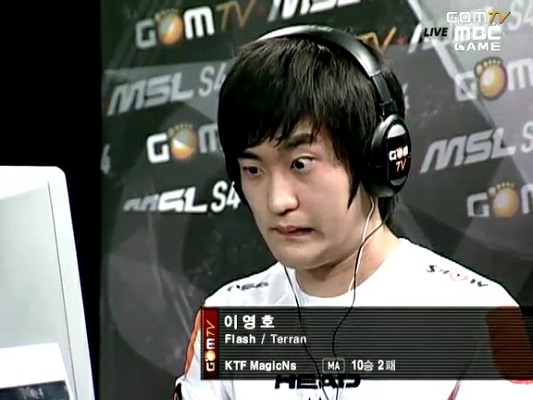
Side effects of being an “all-in gamer” include international fandom, becoming the best StarCraft player known to mankind, and eye spasms.***
If you really like drawing cards and really don’t like combat steps, maybe this will be more appropriate for you:
Creatures (26)
- 4 Elvish Visionary
- 3 Arbor Elf
- 4 Bloodthrone Vampire
- 1 Snapcaster Mage
- 4 Alchemist's Apprentice
- 4 Blood Artist
- 3 Augur of Bolas
- 3 Deathrite Shaman
Lands (22)
Spells (12)
Sideboard

Now that’s more like it! When you go off with this list, you keep going off until your opponent is dead. Elvish Visionary, Alchemist’s Apprentice, and Augur of Bolas all help you find Immortal Servitude, and Grisly Salvage with Tracker’s Instincts make sure the stream of creatures never stops flowing. With a total of seventeen spells that replace themselves with another card (not counting Immortal Servitude), there is never a shortage of plays in this deck.
The three Arbor Elfs help accelerate and also serve as a spell that can actually be cast for an odd number of mana (a rare issue that occurs when a large majority of your deck costs exactly two mana). The prospect of milling all four copies of Immortal Servitude is a scary one, so the one Snapcaster Mage is a precaution in case that happens. When Grisly Salvage or Tracker’s Instincts hits an Immortal Servitude, the only option is to let the sorcery go to the graveyard, while a Snapcaster Mage can always be taken.
This deck doesn’t really have a plan B (though sometimes Bloodthrone Vampire gets there!), but there aren’t too many ways people can completely shut off Immortal Servitude in game 1. Things may get tricky after sideboarding, but the deck draws so many cards that the sideboarded cards can be found.
The Temple Gardens may look a little strange in a deck with no need for white mana in its 75. As it turns out, a triple black card is pretty hard to cast in a three-color deck, so the Temple Gardens serve to help cast Immortal Servitude as well as being an untappble Forest for Arbor Elf. Another card that may raise a few eyebrows is the sideboard Craterhoof Behemoth. Its inclusion is in case of a Slaughter Games in sideboarded games naming either Blood Artist or Immortal Servitude (both are pretty disastrous for this deck). Aside from that, the sideboard handles the problem cards discussed above, with some Duresses to deal with countermagic.
I don’t expect Immortal Servitude to become the next boogeyman of the format, but it is a subtly potent strategy that inhabits a currently unoccupied niche in the metagame. I wouldn’t be surprised to see it put up strong finishes in the near future, especially if midrange starts becoming the strategy to beat. Plus, who doesn’t love doing awesome things with “bad” cards? That’s all I have for today, and I hope you guys enjoyed my article!
Until next time,
Twitter/Twitch/Magic Online: Sunyveil
Classical Music Enthusiast 😀
*This does not reflect my personal view.
**Bonus points if you read this in Evan Erwin voice!
***Fun fact for those of you StarCraft fans out there: before Flash was called “The Ultimate Weapon” and terrorized South Korea with his APM and fast expands, he was invited to a special sixteen-man tournament hosted by GomTV. In the promos for that tournament, each programmer was introduced along with his nickname. Not having a nickname at that time and with the recent memory of cheesing Bisu out of the OSL, Flash was introduced as “All-In Gamer Lee Young Ho.” He won that tournament, of course.

